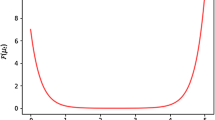Abstract
We consider the solution of the equation r(t) = W(r(t)), r(0) = r 0 > 0 where W(⋅) is a fractional Brownian motion (f.B.m.) with the Hurst exponent α∈ (0,1). We show that for almost all realizations of W(⋅) the trajectory reaches in finite time the nearest equilibrium point (i.e. zero of the f.B.m.) either to the right or to the left of r 0, depending on whether W(r 0) is positive or not. After reaching the equilibrium the trajectory stays in it forever. The problem is motivated by studying the separation between two particles in a Gaussian velocity field which satisfies a local self-similarity hypothesis. In contrast to the case when the forcing term is a Brownian motion (then an analogous statement is a consequence of the Markov property of the process) we show our result using as the principal tools the properties of time reversibility of the law of the f.B.m., see Lemma 2.4 below, and the small ball estimate of Molchan, Commun. Math. Phys. 205 (1999) 97–111.
Similar content being viewed by others
References
P. Billingsley, Convergence of Probability Measures, 2nd ed. (Wiley & Sons, 1999).
M. Chaves, P. Horvai, K. Gawedzki, A. Kupiainen and M. Vergassola, Lagrangian dispersion in Gaussian self-similar velocity ensembles, J. Stat. Phys. 113:643–692 (2003).
L. K. Chung, A Course in Probability Theory (Harcourt, Brace & World Inc., 1968).
L. Decreusefond and A. S. Üstünel, Stochastic analysis of the fractional Brownian motion, Potential Anal. 10:177–214 (1998).
U. Frisch, Turbulence. The Legacy of A. N. Kolmogorov (Cambridge University Press, Cambridge, 1995).
I. Karatzas and S. Shreve, Brownian Motion and Stochastic Calculus (Springer, 1991).
R. Kraichnan, Diffusion in a random velocity field, Phys. Fluids 13:22–31 (1970).
N. L. Lanjri-Zadi and D. Nualart, Smoothness of the law of the supremum of the fractional Brownian motion, Electr. Comm. Prob. 8:102–111 (2003).
G. M. Molchan, Maximum of a fractional Brownian motion: Probabilities of small values, Commun. Math. Phys. 205:97–111 (1999).
A. S. Monin and A. M. Yaglom, Statistical Hydrodynamics, v. II (in Russian) (Nauka, Moscow, 1967).
Y. A. Rozanov, Stationary Random Processes (Holden-Day, 1967).
G. Samorodnitsky and M. Taqqu, Stable Non-Gaussan Random Processes. Stochastic Models with Infinite Variance (Chapman & Hall, New York, London, 1994).
J. Vives and D. Nualart, Continuité absolute de la loi du maximum d’un processus continu, C.R. Acad. Sci. Paris 307:349–354 (1988).
Author information
Authors and Affiliations
Corresponding author
Rights and permissions
About this article
Cite this article
Horvai, P., Komorowski, T. & Wehr, J. Finite Time Approach to Equilibrium in a Fractional Brownian Velocity Field. J Stat Phys 127, 553–565 (2007). https://doi.org/10.1007/s10955-006-9270-0
Received:
Accepted:
Published:
Issue Date:
DOI: https://doi.org/10.1007/s10955-006-9270-0




